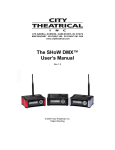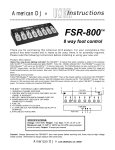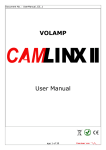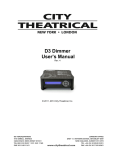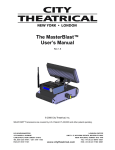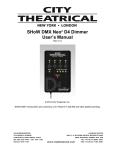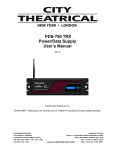Download The WDS Wireless Data System User Manual
Transcript
The WDS Wireless Data System™ Operator’s Manual Rev 1.9.1 © 2007 City Theatrical, Inc. The WDS Wireless Data System™ page 2 CONTENTS Welcome to the WDS Wireless Data System ............................................................................5 Getting Started with the WDS Wireless Data System................................................................5 The WDS Transmitter # 5500 (200MW) or #5501 (10MW)........................................................7 The WDS Receiver #5510 .........................................................................................................9 The WDS Rx2 Receiver #5512 ................................................................................................11 The 15A Dimmer #5520 ...........................................................................................................14 The WDS Personal Dimmer #5515..........................................................................................17 Personal Dimmer Radio Controls .........................................................................................18 Personal Dimmer Operating and Protective Features..........................................................19 Switch Diagnostics ...............................................................................................................20 The OEM Receiver #5505 .......................................................................................................21 Operating the WDS OEM Receiver (Rx) ..............................................................................22 Standard Accessories ..........................................................................................................23 Applications in City Theatrical’s PDS Range ...........................................................................24 The Four Port Opto-Receiver #5514........................................................................................25 The WDS Candle Adapter #5580 ............................................................................................27 User Application Notes: ........................................................................................................28 Batteries and Power Considerations ....................................................................................29 Working in the Wireless World .................................................................................................33 Range...................................................................................................................................33 Interference ..........................................................................................................................33 Accessories ..........................................................................................................................33 General Specifications .............................................................................................................34 Unit Specifications ...................................................................................................................34 FIGURES Figure 1, Typical WDS System Riser.........................................................................................5 Figure 2, WDS Transmitter Front and Back Panels ...................................................................7 Figure 3, Transmitter LED Key ..................................................................................................8 Figure 4, WDS Receiver Top and Back Panels .........................................................................9 Figure 5, Receiver LED Key ....................................................................................................10 Figure 6, Radio Selection Chart ...............................................................................................10 Figure 7, Rx2 Receiver ............................................................................................................11 Figure 8, Rx2 LED Key ............................................................................................................12 Figure 9, Radio Selection Chart ...............................................................................................12 Figure 10, 15A Dimmer Top and Front Panel ..........................................................................14 Figure 11, 15A Dimmer LED Key.............................................................................................14 Figure 12, Mode Switch Selection Chart..................................................................................15 Figure 13, Switch Diagnostics..................................................................................................16 Figure 14, WDS Personal Dimmer...........................................................................................17 Figure 15, Radio & Dip Switch Key ..........................................................................................18 Figure 16, PD Radio LED Key .................................................................................................18 Figure 17, PD Dimmer LED Key ..............................................................................................18 Figure 18, PD Mode Dip Switch Key........................................................................................19 Figure 19, XLR Tail Pin Configuration .....................................................................................19 Figure 20, PD Switch Diagnostics............................................................................................20 Figure 21, WDS OEM Receiver Card Layout...........................................................................21 The WDS Wireless Data System™ page 3 Figure 22, Receiver LED Key ..................................................................................................22 Figure 23, Radio Selection Switch Chart .................................................................................22 Figure 24, Accessories Available for WDS OEM Rx Kit...........................................................23 Figure 25, WDS Equipped PDS Products................................................................................24 Figure 26, WDS/PDS Riser Example.......................................................................................24 Figure 27, WDS Four Port Opto-Reciever ...............................................................................25 Figure 28, Four Port Opto-Receiver, Top Panel ......................................................................25 Figure 29, Four Port Opto-Receiver LED Key..........................................................................26 Figure 30, Four Port Opto-Receiver Rotary and DIP Switch Key ............................................26 Figure 31, WDS Candle Adapter .............................................................................................27 Figure 32, 5580 Candle Adapter, Physical Layout...................................................................27 Figure 33, CANDLE ADAPTER TYPICAL RISER ...................................................................28 Figure 34, Typical Single 12V Battery System.........................................................................29 Figure 35, Typical Continuous Battery Life for 12AH Battery...................................................30 Figure 36, Two Battery 12V (parallel) System .........................................................................30 Figure 37, Two Battery 24V (series) System ...........................................................................31 Figure 38, Typical WDS System with Personal Dimmer ..........................................................32 Figure 39, WDS Accessory List ...............................................................................................33 The WDS Wireless Data System™ page 4 ** Does not Include France or Spain Other Countries: Some countries not listed accept emissions / broadcast radio compliance certifications from the countries listed above. Other national compliance certification applications are pending and may be secured in the future. For current information about a country not listed above, please contact City Theatrical. The WDS Wireless Data System™ page 5 Welcome to the WDS Wireless Data System Thank you for choosing the WDS Wireless Data System™. The WDS System has been engineered to be reliable, roadworthy, easy to use, and compatible with other standard 2.4GHz wireless data and communications systems. Every effort has been made to anticipate your questions in this manual, but if you have any questions that are not answered here, or you want to discuss a special application, please feel free to contact us directly at City Theatrical. The WDS System includes a wide range of products which you may review at our website (www.citytheatrical.com) or in our catalog. For basic operation, a minimum of one WDS Transmitter and one WDS Receiver is required. Getting Started with the WDS Wireless Data System Setting up a WDS system is quite similar to setting up any DMX512 based system. The principle thing to remember is that the WDS Transmitter and Receiver(s) replace DMX cable. System Flow: DMX 512 control data from any standard DMX 512 console is output to the WDS Transmitter, which converts that DMX data to a radio signal and broadcasts it to the WDS Receiver (or Receivers). The WDS Receiver takes the radio broadcast and converts it back into standard DMX 512 data, which can than be connected via standard cables to WDS 15A Dimmers or any other DMX devices such as moving lights, effects, etc. LOAD TRANSMITTER 12 ~ 24V BATTERY 0 15A DIMMER DMX 512 CONTROL CABLE FROM CONSOLE TO TRANSMITTER LIGHTING CONSOLE RECEIVER Figure 1, Typical WDS System Riser The WDS Wireless Data System™ page 6 Connection and configuration of a typical WDS System: 1. Install the WDS Transmitter in a convenient location within range1 of the desired Receiver location(s). Transmitters should be elevated above the audience (or other barriers) whenever possible; height is good! 2. Set the WDS Transmitter’s radio channel via the Radio Channel rotary switch (1 through 8) and System ID 2 position DIP switch (see Figure 2 for details.) The Transmitter and Receiver radio channel and system ID settings must match for them to communicate. 3. Connect the DMX 512 Console’s DMX output to the WDS Transmitter via a standard DMX 512 cable and then connect the transmitter power supply. After the unit is powered up and initializes itself, the status LEDs will read: a. POWER/DMX IN: Amber b. RF OUT: Amber 4. Set the WDS Receiver’s radio channel to match the Transmitter via its channel rotary switch and system ID two position DIP switch. 5. Connect Receiver power using either a WDS DC power adapter (#5525 or #5527) or a WDS Battery Cable (#5550, #5552, #5554, or #5556). After power up and initialization, the Receiver status LEDs will read: a. POWER/IN RANGE: Amber b. RF IN/DMX OUT: Amber 6. Set the Dimmer’s DMX address to any desired value between 1 and 512 using the DMX address switches. 7. Connect the Dimmer to (battery) power via the POWER IN connectors, and connect the load via the DIMMER OUT connectors. After power up and initialization, the Dimmer POWER/STATUS LED should be blinking green. 8. Connect the Receiver’s DMX output to the DMX input of the WDS Dimmer. The Dimmer POWER/STATUS LED should now be solid green. 9. Test the load connection using the TEST/bump button. 10. When the Dimmer is brought up to a level, the POWER/STATUS LED will track the level dimming between Green at OFF and Amber at FULL. About the LEDs: All of the WDS Status LEDs are bi-color, meaning they each contain a red and a green LED element. When both elements are fired, the LED will appear amber. 1 (see Working in the Wireless World, page 33) The WDS Wireless Data System™ page 7 The WDS Transmitter # 5500 (200MW) or #5501 (10MW) 0 FRONT VIEW REAR VIEW Figure 2, WDS Transmitter Front and Back Panels The WDS Transmitter receives standard DMX 512 via its DMX INPUT, and broadcasts that DMX data as a radio signal. The Transmitter is equipped with the following features (see Figure 2): Front Panel: 1. Antenna: The antenna is multi-positional and may easily be removed for shipping or storage; unscrew to remove. Be sure not to over-tighten when attaching the antenna as the internal cabling may break. 2. RF OUT LED (item 2): This LED indicates inter-processor communication and RF broadcast. During normal operation, the LED will flash green briefly to indicate the internal processors are communicating. Once valid DMX is established, this LED will go to steady amber to indicate that the Transmitter is broadcasting. 3. Power/DMX IN LED (item 3): This LED will light green to indicate power is connected, and change to red/amber when ever DMX input is detected. It flashes between green and amber if DMX is lost after being detected. The WDS Wireless Data System™ page 8 LED Indicator Color/Status Momentary Flash Green/Red Indication CPUs Communicating, System Ready RF OUT LED (item 2) Steady Amber Transmitting Steady Amber DMX Data Present Power/DMX IN LED (item 3) Flashing between Green and Amber Power ON, No DMX Figure 3, Transmitter LED Key 4. RADIO ID CHANNEL select switch: Switch positions 1-8 select (settings 9 & 0 are reserved for diagnostics and special functions.) 5. ID DIP switch: This 2 position DIP switch works with the Radio Channel select switch to permit selection of any of the 32 available radio channels, as per the chart below. Note: On the Transmitter, these switches are OFF when they are UP. Radio Channel Select Switch ID DIP Switch Radio Channels 1-8 OFF OFF 1–8 1-8 ON OFF 9 – 16 1-8 OFF ON 17 – 24 1-8 ON ON 25 – 32 6. RESET switch: This switch is recessed to prevent unintentional operation. Press with a pen or other similar device to reset the Transmitter’s internal processors. Back Panel: 7. DMX INPUT, 5P XLR Male: This is a standard DMX 512 input. Connect to the desired output port of your console to broadcast that port’s DMX 512 data. 8. DMX PASS-THRU, 5P XLR Female: This Pass-Thru is provided to allow connection of down-stream DMX devices. The WDS Transmitter DMX output is optically isolated from the input, CPU set, and other Transmitter circuitry. DMX INPUT/PASS-THRU special features: • The DMX INPUT is provided with auto-termination, so no other end-of-line termination setting is required. • During normal operation, the WDS Transmitter regenerates the DMX 512 DATA presented at the Pass-Thru output, so the output may supply a full compliment of DMX load. • If the power supply is removed or other system failure occurs, the DMX input will automatically be switched over to a hardwired connection to the pass-thru, assuring continued delivery of the DMX data to down stream devices. 9. +12V power supply connection: Connect the Mains Power/+12V adapter here to power the unit. CE Compliance: The #5501 (10MW) Transmitter is available in a CE compliant version. The WDS Wireless Data System™ page 9 The WDS Receiver #5510 6 8 7 4 5 3 2 1 Figure 4, WDS Receiver Top and Back Panels The WDS Receiver receives DMX data as a radio signal, and outputs that data as standard DMX 512 via its DMX OUTPUT connector. The Receiver is equipped with the following features (see Figure 2): 1. Antenna: The antenna is multi-positional and may easily be removed for shipping or storage; unscrew to remove. Be sure not to over-tighten when attaching the antenna as the internal cabling may break 2. POWER/IN RANGE LED (D4): This LED indicates the unit has Power and is in range of a Transmitter. This LED will light Green to indicate power is connected, and change to Amber whenever a correctly configured Transmitter is detected. The WDS Wireless Data System™ page 10 3. RF IN/DMX OUT LED (D3): This LED lights Green when the unit is receiving RF DMX data and Red when outputting standard DMX. Since the unit begins outputting DMX as soon as it receives RF, this LED normally appears amber when receiving/outputting. LED Indicator POWER/IN RANGE (2) RF IN/DMX OUT (3) Color/Status Green Amber Green Amber Indication Power Connected Transmitter Detected Receiving RF DMX Outputting DMX Figure 5, Receiver LED Key 4. RADIO CHANNEL select switch: Switch positions 1-8 select (settings 9 & 0 are reserved for diagnostics and special functions). 5. ID DIP switch: This 2 position DIP switch works with the Radio Channel select switch to permit selection of any of the 32 available radio channels, as per the following chart: Radio Channel Select Switch 1-8 1-8 1-8 1-8 ID DIP Switch OFF OFF ON OFF OFF ON ON ON Radio Channels 1-8 9 - 16 17 - 24 25 - 32 Figure 6, Radio Selection Chart 6. RESET switch: This switch is recessed to prevent unintentional operation. Press with a pen or other similar device to reset the Receiver’s internal processors. 7. DMX OUTPUT, 5P XLR Female: This is a standard DMX 512 output. Connect to WDS Dimmers or other DMX devices. 8. +12V power supply connection. Connect the Mains Power/+12V adapter or +12V battery here to power the unit. CE Compliance The #5510 Receiver is available in a CE compliant version. The WDS Wireless Data System™ page 11 The WDS Rx2 Receiver #5512 9 7 3 2 4 5 6 1 8 Figure 7, Rx2 Receiver The WDS Rx2 Receiver is a full-featured WDS Wireless DMX Receiver for use wherever a mains powered wireless DMX Receiver is needed. The WDS Rx2 receives DMX data as a radio signal, and outputs that data as standard DMX 512 via its DMX OUTPUT The WDS Wireless Data System™ page 12 connector. The Rx2 is ETL Listed to UL 508A and is available in a CE compliant version. The socket-outlet shall be installed near the equipment and shall be easily accessible, i.e., do not run excessively long extensions cords of insufficient gauge to power the unit. The Rx2 is equipped with the following features: 1. Antenna: The antenna is multi-positional and may easily be removed for shipping or storage; unscrew to remove. Be sure not to over-tighten when attaching the antenna as the internal cabling may break. 2. POWER LED (L1): This LED indicates the unit has power and is in range of a Transmitter. This LED will light red to indicate power is connected, and change to amber whenever a correctly configured Transmitter is detected. 3. RF LED (L2): This LED lights Red when the unit is receiving RF DMX data and green when outputting standard DMX. Since the unit begins outputting DMX as soon as it receives RF, this LED normally appears amber when receiving/outputting. L1 L2 Status Red Power ON, No Tx Detected Amber Amber Tx Detected, DMX Transmitting Red Red Tx Detected, DMX Lost Figure 8, Rx2 LED Key 4. RADIO CHANNEL select switch: Switch positions 1-8 select (settings 9 & 0 are reserved for diagnostics and special functions). 5. ID DIP switch: This 2 position DIP switch works with the Radio Channel select switch to permit selection of any of the 32 available radio channels, as per the chart below. Note ON/OFF markings on the DIP switches. Radio Channel Select Switch ID DIP Switch Radio Channels 1-8 OFF OFF 1-8 1-8 ON OFF 9 - 16 1-8 OFF ON 17 - 24 1-8 ON ON 25 - 32 Figure 9, Radio Selection Chart 6. RESET switch: This switch is recessed to prevent unintentional operation. Press with a pen or other similar device to reset the Rx2’s internal processors. 7. DMX OUTPUT, 5P XLR Female: This is a standard DMX 512 output. Connect to WDS Dimmers or other DMX devices 8. Auto-ranging Mains Power Connection: Connect to 100~240 VAC 50/60 Hz. Although provided with a standard North American NEMA 5-15P (“Edison”) power plug, the Rx2 will work with any mains power voltage within the 100~240 VAC 50/60 Hz range. 9. C-Clamp Attachment: The Rx2 can be fitted with a standard theatrical C-Clamp for pipe and truss mounting. The WDS Wireless Data System™ page 13 Fuse Replacement In the event that your Rx2’s fuse has blown, it can be replaced by a qualified individual. Remove the (4) flat head Philips screws securing the cover, locate the fuse on the power supply circuit board and carefully remove. Replace with a .25A 250V 2AG/5mm fuse, carefully snapping it into place. Replace the cover and screws, and test the unit to make sure it is working properly. The WDS Wireless Data System™ page 14 The 15A Dimmer #5520 TOP VIEW 5 FRONT VIEW 3 4 1 8 9 6 7 2 Figure 10, 15A Dimmer Top and Front Panel 1. STATUS/POWER LED: This single Bi-Color LED indicates the status of a number of things including power, DMX, and output. The LED conditions are as follows: LED State/Color Regular blinking Green Solid Green Solid Amber Flashing between Red and Green/Amber Flashing Red Condition Dimmer has power, CPU is running DMX Present, Output OFF DMX Present, Output FULL DMX Lost, Dimmer holding Last Level Low Battery Figure 11, 15A Dimmer LED Key 2. TEST/BUMP Button: Press to test fire load (the LED will turn amber when the button is pressed.) 3. RESET switch: This switch is recessed to prevent unintentional operation. Press with a pen or other similar device to reset the Dimmer’s internal processors. 4. MODE DIP switch: This 2 position DIP switch selects the operation mode as follows The WDS Wireless Data System™ page 15 Switch Setting OFF OFF ON OFF OFF ON ON ON Function Normal Dimming, ISL Curve NON - DIM Linear Dimming Curve Reserved Figure 12, Mode Switch Selection Chart 5. DMX ADDRESS BCD Rotary Switches: These BCD rotary switches are used to set the unit’s specific DMX address to any value from 1 to 512. 6. POWER IN Anderson Power Pole Connector Set: Connect to Battery Power. Red = +12-24VDC, Black = DC Common. 7. DIMMER OUT Anderson Power Pole Connector Set: Connect to the load to be dimmed. Yellow = + VDC (0-Full), Blue = DC Common . 8. DMX INPUT, 5P XLR Male: This is a standard DMX 512 input. Connect to the DMX output port of the Receiver, or any standard DMX output device. 9. DMX PASS-THRU, 5P XLR Female: This pass-thru is provided to allow connection of downstream DMX devices. DMX INPUT/PASS-THRU special features: • The DMX INPUT is provided with auto-termination, so no other end-of-line termination setting is required. • During normal operation, the WDS 15 Amp Dimmer re-generates the DMX 512 data presented at the Pass-Thru output, so the output may supply a full compliment of DMX load. • If the power supply is removed or other system failure occurs, the DMX input will automatically be switched over to a hardwired connection to the pass-thru, assuring continued delivery of the DMX data to downstream devices. Protective Features • Low Battery Power: If the connected Battery drops below a preset voltage, the Dimmer will shut down, and will not restart until reset (the Low Battery indication will light). This feature protects rechargeable batteries from discharging to the point where they cannot be recharged with a standard charger. The standard factory set cut-off point is 7VDC. Other settings are available on a custom basis; please consult City Theatrical. • Internal Watchdog for DMX processor and Dimmer Processor: If the DMX processor fails, the LED will flash at 1 sec interval (red or amber depending on DMX failure mode) and the load output will be turned off, protecting the battery and load. If the Dimmer processor fails, the load output will be turned off, protecting the battery and load. • Internal reverse power polarity protection: The internal power supply circuitry is designed to protect the control electronics from damage if the battery leads are accidentally reversed or plugged into the DIMMER OUTPUT connection. The WDS Wireless Data System™ page 16 • Hold Last valid DMX Level: If DMX is lost, the WDS 15A Dimmer will hold the last valid level for about 5 minutes, and then fade to black. Switch Diagnostics Setting the BCDs to the settings shown below and resetting the unit will start the following diagnostic self tests: BCD Settings MODE DIP Settings Function Tested 601 Ones (1s) BCD 602 Tens (10s) BCD 603 Hundreds (100s) BCD 604 605 00 01 10 11 DIP Switch DIP Switch DIP Switch DIP Switch Manually Set Output Level Indication LED Will flash = to the number the “1s” BCD is set to LED Will flash = to the number the “10s” BCD is set to LED Will flash = to the number the “100s” BCD is set to No LED Flashes 1 LED Flash 2 LED Flashes Fast Red/Green/Amber Flashes After reset move the tens and ones BCD switches to manually set the lamp to a % level Figure 13, Switch Diagnostics The BCD test setting must be set (as above) ether before power is applied or reset is pressed. Fuse Replacement The 15A Dimmer contains a replaceable ATO 15A Fuse. Refer to qualified service personnel if your unit needs a fuse replacement. Wire Gauge When installing this unit in a system, City Theatrical recommends 12 gauge wiring between all line and load devices to minimize voltage drop, otherwise significant damage could result to the equipment. Operating Temperature Maximum ambient operating temperature is 40°C. CE Compliance The #5520 15A Dimmer is available in a CE compliant version. Look for the CE marking to verify. The WDS Wireless Data System™ page 17 The WDS Personal Dimmer #5515 The WDS Personal Dimmer combines a WDS DC Dimmer with its own dedicated 2.4GHz Receiver to provide wireless dimming in a very small, lightweight and concealable package that can be worn with the provided belt clip, or hidden in a prop or set piece. The Personal Dimmer is internally fused at 5A. Features: • Integral 32 Channel 2.4GHz WDS Receiver • Integral Class 2 power limited 5A Dimmer • Operating power range +9~24 VDC • Very small size • Use with belt clip or mount flat in prop or set piece • Works with Standard WDS Transmitter • Can be used in any WDS system with all other WDS products 1 2 3 4 5 6 7 8 9 10 11 Figure 14, WDS Personal Dimmer The WDS Wireless Data System™ page 18 Personal Dimmer Radio Controls 1. POWER/IN RANGE LED (D4): This LED indicates the unit has power and is in range of a Transmitter. This LED will light green to indicate power is connected, and change to amber whenever a correctly configured Transmitter is detected. 2. ID DIP switch: This 2 position DIP switch works with the radio channel select switch to permit selection of any of the 32 available radio channels, as per the following chart: Radio Channel Select Switch ID DIP Switch Radio Channels 1-8 OFF OFF 1-8 1-8 ON OFF 9 - 16 1-8 OFF ON 17 - 24 1-8 ON ON 25 - 32 Figure 15, Radio & Dip Switch Key 3. RADIO CHANNEL select switch: Switch positions 1-8 select (settings 9 & 0 are reserved for diagnostics and special functions). 4. RF IN/DMX OUT LED (D3): This LED lights green when the unit is receiving RF DMX data and red when outputting standard DMX. Since the unit begins outputting DMX as soon as it receives RF, this LED normally appears amber when receiving/outputting. Radio LED Indicator Color/Status Indication Green Power Connected POWER/IN RANGE Amber Transmitter Detected Green Receiving RF DMX RF IN/DMX OUT Amber Outputting DMX Figure 16, PD Radio LED Key 5. RESET switch: This switch will reset the entire Personal Dimmer unit (both Radio receiver and Dimmer). It is recessed to prevent unintentional operation. Press with a pen or other similar device to reset the Personal Dimmer’s internal processors. 6. STATUS/POWER LED: This single Bi-Color LED indicates the status of a number of things including power, DMX, and output. The LED conditions are as follows: Dimmer LED State/Color Condition Regular blinking Green Dimmer has power, CPU is running Solid Green DMX Present, Output OFF Solid Amber DMX Present, Output FULL Flashing between Red and Green/Amber DMX Lost, Dimmer holding Last Level Flashing Red Low Battery Figure 17, PD Dimmer LED Key The WDS Wireless Data System™ page 19 7. DMX ADDRESS BCD Rotary Switches: These BCD rotary switches are used to set the unit’s specific DMX address to any value from 1 to 512. 8. TEST/BUMP Button: Press to test fire load (the LED will turn amber when the button is pressed). 9. MODE DIP switch: This 2 position DIP switch selects the operation mode as follows: Switch Setting Function OFF OFF Normal Dimming, ISL Curve ON OFF NON - DIM OFF ON Linear Dimming Curve ON ON Reserved Figure 18, PD Mode Dip Switch Key 10. 4P XLR Tail for power input and load output connections: Pin Function 1 Input DC Common 2 Input 9~12 +VDC 3 Output DC Common 4 Output Dimmed +VDC Figure 19, XLR Tail Pin Configuration 11. Flexible antenna Personal Dimmer Operating and Protective Features • Class 2 Power Limitation: Because the Personal Dimmer is intended for use in installations where actors, dancers and technicians may come into regular contact with the unit while it is operating, it is pre-configured as an NEC 725 Class 2 low power device with a 12V 5A / 60W maximum power limitation. If control is needed for higher voltage or higher wattage devices, the standard 15A Dimmer or 30A Custom Dimmer should be used. • 9V Battery operation: The WDS Personal Dimmer will operate with small loads from a single 9V Battery. In a typical application, the Personal Dimmer with a .150A load will run for up to two hours on a single 9V Battery. Two or more batteries may be connected in parallel for extended operation or higher loads. • Low Battery Power Sense: If the connected Battery drops below a preset voltage, the Dimmer will shut down, and will not restart until reset (the Low Battery indication will light). This feature protects rechargeable batteries from discharging to the point where they cannot be recharged with a standard charger. The standard factory set cut-off point for the Personal Dimmer is 5.5VDC. Other settings are available on a custom basis, please consult City Theatrical. The WDS Wireless Data System™ page 20 • Internal Watchdog for DMX processor and Dimmer Processor: If the DMX processor fails, the LED will flash at 1 sec interval (red or amber depending on DMX failure mode) and the load output will be turned off, protecting the battery and load. If the Dimmer processor fails, the load output will be turned off, protecting the battery and load. • Internal reverse power polarity protection: The internal power supply circuitry is designed to protect the control electronics from damage if the battery leads are accidentally reversed or plugged into the DIMMER OUTPUT connection. • Hold Last valid DMX Level: If DMX is lost, the WDS PD will hold the last valid level for about 5 minutes, and then fade to black. Switch Diagnostics Setting the BCDs to the settings shown below and resetting the unit will start the following diagnostic self tests: BCD Settings MODE DIP Settings Function Tested 601 Ones (1s) BCD 602 Tens (10s) BCD 603 Hundreds (100s) BCD 604 605 00 01 10 11 DIP Switch DIP Switch DIP Switch DIP Switch Manually Set Output Level Indication LED Will flash = to the number the “1s” BCD is set to LED Will flash = to the number the “10s” BCD is set to LED Will flash = to the number the “100s” BCD is set to No LED Flashes 1 LED Flash 2 LED Flashes Fast Red/Green/Amber Flashes After reset move the tens and ones BCD switches to manually set the lamp to a % level Figure 20, PD Switch Diagnostics The BCD test setting must be set (as above) either before power is applied or reset is pressed. The WDS Wireless Data System™ page 21 The OEM Receiver #5505 The 5505 WDS OEM Wireless DMX 512 Receiver can be built into any DMX device, providing instant cable-free connectivity with the mission critical reliability of 2.4GHz Frequency Hopping Spread Spectrum (FHSS) technology. For installation instructions, please refer to “The WDS OEM™ Wireless DMX Receiver Installation and User’s Guide.” The WDS OEM Wireless Receiver includes the following features: • Works with standard WDS Transmitter • Miniature size (1.95” x 2.65”) PCBA • Advanced surface mount technology • 4 layer FR4 UL94-V0 PC Board • Status LEDs for radio functions, power and DMX output • DMX512 Output via 5 pin .100” Header • Reception capability: 512 channels of DMX 512 data (1 full universe) • 32 user selectable FHSS hopping patterns • Typical effective range: o 400 ~ 600’ indoors with standard antennas (line of sight) o 1000’ ~ 1500’ outdoors with standard antennas (line of sight) o 800 yards ~ several miles, with high power directional antennas, depending on transmitter power, antennas and broadcast environment • Compliance: o CE Certified, RoHS Compliant o 10 mW Transceiver - US (FCC15.247), Canada (IC), Europe (EN, Does not include France or Spain) OEM RADIO TRANSCEIVER RADIO ID BCD SWITCH RESET SWITCH RADIO ID DIP SWITCH L2 LED L1 LED OEM Rx PCBA 4-40 NYLON TRANSCEIVER MOUNTING HARDWARE OEM Rx ASSEMBLY MOUNTING HOLE Figure 21, WDS OEM Receiver Card Layout The WDS Wireless Data System™ page 22 Operating the WDS OEM Receiver (Rx) The WDS OEM Rx receives DMX data as a radio signal, and outputs that data as standard DMX 512 via its DMX OUTPUT connector, just like other WDS products. The only difference is the WDS OEM Rx can be installed in any number of devices not manufactured directly by City Theatrical. The OEM Rx is equipped with the following features: 1. Antenna: The OEM Rx will work with a number of antennas. City Theatrical stocks a small flexible “Rubber Ducky” with integral cable and a (longer range) 7” adjustable/ removable unit that uses a separate cable. Kits will be equipped based on your specific application and order. 2. POWER LED (L1): This LED indicates the unit has power and is in range of a Transmitter. This LED will light red to indicate power is connected, and change to Amber whenever a correctly configured Transmitter is detected. 3. RF LED (L2): This LED lights red when the unit is receiving RF DMX data and green when outputting standard DMX. Since the unit begins outputting DMX as soon as it receives RF, this LED normally appears amber when receiving/outputting. L1 L2 Status Red Power ON, No Tx Detected Amber Amber Tx Detected, DMX Transmitting Red Red Tx Detected, DMX Lost Figure 22, Receiver LED Key 4. RADIO CHANNEL select switch: Switch positions 1-8 select (settings 9 & 0 are reserved for diagnostics and special functions). 5. ID DIP switch: This 2 position DIP switch works with the radio channel select switch to permit selection of any of the 32 available radio channels, as per the following chart: Radio Channel Select Switch ID DIP Switch Radio Channels 1-8 OFF OFF 1-8 1-8 ON OFF 9 - 16 1-8 OFF ON 17 - 24 1-8 ON ON 25 - 32 Figure 23, Radio Selection Switch Chart 6. RESET switch: This switch is recessed to prevent un-intentional operation. Press with a pen or other similar device to reset the OEM Rx’s internal processors. 7. DMX OUTPUT, 5P .100 Header: This is a standard DMX 512 output. Connect to Host equipment DMX input or 5P XLR Female for Standard DMX Output. 8. +5VDC power supply connection: connect to APS or user provided +5VDC Source. The WDS Wireless Data System™ page 23 In units modified by City Theatrical, there will be a mechanical indicator switch (“wink switch”) which changes the unit from ‘wired’ to ‘wireless’ DMX. By engaging this switch, the unit can be run with wired DMX, or with wireless DMX. Standard Accessories A wide range of accessories for implementing a WDS OEM Rx kit to your specific needs is available (see below). In addition, City Theatrical will be happy to develop and provide custom parts, interfaces, or accessories for any unique WDS requirement. WDS OEM Rx Accessories DC/DC APS Card APS Card OEM Rx Base Kit Omni-Directional Antenna Antenna Cable City Theatrical Part # CTI # 5506 CTI # 5507 CTI # 5508 CTI # 5530 CTI # 5531 Figure 24, Accessories Available for WDS OEM Rx Kit The WDS Wireless Data System™ page 24 Applications in City Theatrical’s PDS Range City Theatrical has incorporated its WDS technology into its PDS products enabling quick and convenient integration of WDS with Color Kinetics® ColorBlast®, ColorBurst®, and iColor® Cove intelligent solid-state lighting fixtures. Refer to “The OEM Receiver #5505” (pg. 21) for usage of WDS in these products. The PDS-375 TRw and PDS-750 TRw utilize a mechanical indicator switch to change the operation of unit between ‘wired’ and ‘wireless.’ PDS Products Equipped with WDS PDS-50 PDS-375 TRB PDS-375 TRw PDS-750 TRB PDS-750 TRw Wireless Chromasic PDS City Theatrical Part # CTI # 6255 CTI # 6265 CTI # 6251 CTI # 6260 CTI # 6261 CTI # 6290 Figure 25, WDS Equipped PDS Products The WDS and PDS products can be used in a variety of ways. Below is a simple riser diagram relating one way City Theatrical’s WDS system can be incorporated to power a number of Color Kinetic fixtures. BATTERY POWERED FIXTURE RECEIVING DATA VIA A PDS-50 DMX BROADCAST AS 2.4GHz RADIO SIGNAL CB-12, CB-6, OR I-COLORCOVE WDS TRANSMITTER LOAD 0 W DS LOAD PDS-375 STATUS PDS-375-TR RESET 6 5 4 3 2 1 FAULT TM P ATENT PENDING DMX 512 FROM CONSOLE TO TRANSMITTER DMX: 100's 10's 1's LOAD CONFIG LOAD LOAD DMX LIGHTING LOAD CONTROL CONSOLE -PDS-375 RUNS 6 FIXTURES -PDS-750 WILL RUN 12 FIXTURES Figure 26, WDS/PDS Riser Example The WDS Wireless Data System™ page 25 The Four Port Opto-Receiver #5514 A new addition to City Theatrical’s WDS line is the CE certified, RoHS compliant, Four Port Opto-Receiver which combines our 2.4GHz Receiver with an optically isolated four port repeater. The unit is housed in a rugged aluminum box complete with 1/2” mounting holes for use with C-clamps, and #10 countersunk screw holes for mounting to scenery. Power is supplied to the unit by means of a 12VDC battery or (included) CTI # 5525 100240VAC 50/60Hz in 12VDC CL 2 power supply. Figure 27, WDS Four Port Opto-Reciever 4 5 6 9 1 8 752 E. 133rd STREET, BRONX NY 10454 718-292-7932 | 800-230-9497 2 7 3 Figure 28, Four Port Opto-Receiver, Top Panel The WDS Four Port Opto-Receiver receives DMX data as a radio signal, and outputs that data as standard DMX 512 via its four DMX OUTPUT connectors. The Four Port is equipped with the following features (see Figure 28). 1. Antenna: The antenna is multi-positional and may easily be removed for shipping or storage; unscrew to remove. Be sure not to over-tighten when attaching the antenna as the internal cabling may break The WDS Wireless Data System™ page 26 2. POWER/IN RANGE LED (item 2): This LED indicates the unit has power and is in range of a Transmitter. This LED will light green to indicate power is connected, and change to amber whenever a correctly configured Transmitter is detected. 3. RF IN/DMX OUT LED (item 3): This LED lights green when the unit is receiving RF DMX data and red when outputting standard DMX. Since the unit begins outputting DMX as soon as it receives RF, this LED normally appears amber when receiving/outputting. LED Indicator POWER/IN RANGE (2) RF IN/DMX OUT (3) Color/Status Green Amber Green Amber Indication Power Connected Transmitter Detected Receiving RF DMX Outputting DMX Figure 29, Four Port Opto-Receiver LED Key 4. RADIO CHANNEL select switch: Switch positions 1-8 select (settings 9 & 0 are reserved for diagnostics and special functions). 5. ID DIP switch: This 2 position DIP switch works with the Radio Channel select switch to permit selection of any of the 32 available radio channels, as per the following chart: Radio Channel Select Switch ID DIP Switch Radio Channels 1-8 OFF OFF 1-8 1-8 ON OFF 9 - 16 1-8 OFF ON 17 - 24 1-8 ON ON 25 - 32 Figure 30, Four Port Opto-Receiver Rotary and DIP Switch Key 6. RESET switch: This switch is recessed to prevent unintentional operation. Press with a pen or other similar device to reset the Receiver’s internal processors. 7. DMX OUTPUTS, 5P XLR Female: These are (4) standard DMX 512 outputs, optically isolated from one another. Connect to WDS Dimmers or other DMX devices. 8. +12V power supply connection: connect the mains power/+12V adapter or +12V battery here to power the unit. 9. OUTPUT LED: Conveys status of DMX output, ON = ACTIVE, OFF = FAULT. The WDS Wireless Data System™ page 27 The WDS Candle Adapter #5580 The 5580 WDS Candle Adapter enables wireless operation and battery dimming of City Theatrical Candle Lite Unlimited™ Flicker Candles (or other brand flicker candles) using either the 5520 WDS 15A Dimmer or the 5515 WDS Personal Dimmer. Candles operated in this manner require the Candle Adapter to optimize the output of the dimmer. Otherwise, they will not flicker properly or dim reliably. 7-12 Figure 31, WDS Candle Adapter ER UT CA OU DI IN 1 LE UT 1-6 3 2 Figure 32, 5580 Candle Adapter, Physical Layout The Candle Adapter has these key features: 1. POWER IN Anderson Power Pole Connector Set: Connect to 15A Dimmer Out. Yellow = + VDC (0-Full), Blue = DC Common. 2. CANDLE OUTPUT LEADS: bare, tinned leads for connecting to candles. Clear (#1) lead is + VDC, Black (#2) lead is DC Common. 3. CANDLE LOAD SWITCH: set switch to range of candles being used to achieve desired dimming curve. The WDS Wireless Data System™ page 28 UP TO 15 CANDLES MAY BE OPERATED OFF OF ONE 5580 CANDLE ADAPTER. CANDLE ADAPTER DMX 512 FROM RECEIVER TO WDS DIMMER CANDLES ARE HARDWIRED TO 5580 CANDLE ADAPTER BY THE END-USER #10 COUNTERSUNK HOLES FOR CONVENIENT MOUNTING DIMMER OUTPUT TO LOAD TRANSMITTER 0 W DS 12 ~ 24V BATTERY 15A DIMMER RECEIVER DMX 512 FROM CONSOLE TO TRANSMITTER Figure 33, CANDLE ADAPTER TYPICAL RISER User Application Notes: The WDS Wireless Data System™ page 29 LOAD WDS-15A WIRELESS DIMMING SYSTEM + 15A DIMMER RECEIVER WIRELESS DIMMING SYSTEM RECEIVER Figure 34, Typical Single 12V Battery System Batteries and Power Considerations Rechargeable 12V batteries used with this system may not charge readily with modern chargers if they are allowed to discharge past ~ 8.5VDC. When allowed to discharge more, the battery may load the charger too much, causing the charger to shut down2 to prevent serious damage. Furthermore, with some loads the current draw will tend to rise as the available voltage drops. If the battery is allowed to discharge too far under these conditions, the current may exceed the limits of the system and cause overheating and/or blow the fuse. For all these reasons, the WDS Dimmer is designed with a low power sensing system that shuts down the dimmer if the battery gets below a safe voltage limit (the standard factory setting is ~9VDC; custom units may be configured with a different limit voltage if needed, consult CTI for details). The WDS 15A Dimmer will control a load of up to 15 amps at any voltage within its rated operating range of 12-24VDC. At 24V the maximum load is 360 watts, while at 12V the maximum load is 180 watts. Typical, continuous use battery life for the standard 12 Amp/Hour CTI 12V rechargeable battery (CTI # 5535) is shown on the next table. 2 If this should happen, the charger may be jump-started by connecting the too-low battery in parallel with a charged battery, starting the charger, and then removing the full battery once the charging has reached a stable point. The WDS Wireless Data System™ page 30 Number of Batteries Load Voltage Battery Wiring Typical Battery Life per charge n/a Total watts Load 150 1 12 2 2 24 12 Series Parallel 300 150 20~25 minutes 40~50 minutes Example of typical load types 2 x 75W MR 16 lamps 24V Lamps 2 x 75 W MR 16 lamps 20~25 minutes Figure 35, Typical Continuous Battery Life for 12AH Battery For extended 12V operation, 2 (or more) batteries may be connected together in parallel as suggested in the table above (see Figure 36). For 24V operation, 2 batteries may be connected in series so that the battery voltages add together (see Figure 37). LOAD WDS-15A + WIRELESS DIMMING SYSTEM + 15A DIMMER RECEIVER WIRELESS DIMMING SYSTEM RECEIVER Figure 36, Two Battery 12V (parallel) System For 24V Dimmer operation, it is recommended that the associated WDS Receiver be powered with 12V from only one of the batteries in the series array (see Figure 37). The WDS Wireless Data System™ page 31 LOAD + WDS-15A WIRELESS DIMMING SYSTEM 15A DIMMER + WIRELESS DIMMING SYSTEM RECEIVER RECEIVER Figure 37, Two Battery 24V (series) System The WDS Wireless Data System™ page 32 W DS DMX 512 FROM CONSOLE TO TRANSMITTER DMX LIGHTING CONTROL CONSOLE 0 WDS WDS RESET IN RANGE radio DIMMER MODE dimmer RF DMX BUMP STATUS CHANNEL ID 1s 10s 100s WDS DMX ADDR INTERNALLY FUSED 5 AMPS wireless dimming system personal dimmer DMX 512 DATA VIA PASS THRU TO NEXT DEVICE DMX 512 DATA VIA PASS THRU TO NEXT DEVICE Figure 38, Typical WDS System with Personal Dimmer LOAD 9 ~ 12V BATTERY LOAD 12 ~ 24V BATTERY LOAD 12 ~ 24V BATTERY OTHER OPTIONAL DMX DEVICE 752 E. 133rd STREET, BRONX NY 10454 WDS VOICE: 718-292-7932 FAX: 718-292-7482 The WDS Wireless Data System™ page 33 Working in the Wireless World Range The theoretical maximum range for the 200mW system, indoor line-of-sight, is ~ 400-600 feet. In practice, range can vary depending on many environmental features, including structural metal in the area, ambient electrical activity, etc. For best results, it is recommended that the system be tested at the installation site to confirm usable range for that site, prior to final location of the equipment. The Transmitter and Receiver(s) should be positioned with a clear line-of-site between the units, and may need to be re-positioned for best results, particularly in electrically noisy or otherwise harsh environments. Interference The WDS system works in the 2.4GHz Broadcast frequency band, which is designated for license-free operation (within regulatory agency limits). This band is used by other equipment, notably 802.11B wireless Ethernet systems. Care should be taken not to place either system’s transmitter in the line-of –sight between the other system’s equipment. Accessories A full range of accessories is available for the WDS Dimming system (see below). Many different complete system configurations can be assembled entirely from the City Theatrical catalog. In addition, City Theatrical will be happy to develop and provide custom parts, interfaces, or accessories for any unique WDS requirement. WDS System Accessory Universal Input (90-240VAC, 50-60Hz) +12VDC CL 2 Power Supply for Transmitter and Receiver 7” Antenna 12V 12AH Rechargeable Battery with Standard Anderson Power Pole Connector Tails 12V 5 A Auto-charger with Standard Anderson Power Pole Connector Tails DMX Cable, 18” Power Twofer, Battery to Receiver and Dimmer 10’ 2/12awg Jumper w/ color coded Anderson Power Pole Connectors 25’ 2/12awg Jumper w/ color coded Anderson Power Pole Connectors 18” 2/14awg Twofer w/ color coded Anderson Power Pole Connectors Anderson 30A Power Pole Connector, Red, w/ crimp terminal Anderson 30A Power Pole Connector, Black, w/ crimp terminal WDS Transmitter 1U Rackmount Bracket (for 1 or 2 Transmitters) WDS Transmitter Pipe Mount Bracket WDS Receiver Pipe Mount Bracket WDS Candle Adapter Custom Mounting Hardware Custom Antennas Figure 39, WDS Accessory List City Theatrical Part # CTI # 5525 CTI # 5530 CTI #5535 CTI # 5540 CTI #5545 CTI # 5550 CTI # 5552 CTI # 5554 CTI # 5556 CTI # 5560 CTI # 5561 CTI # 5565 CTI # 5570 CTI # 5570 CTI # 5580 CTI # 5599 CTI # 5599 The WDS Wireless Data System™ page 34 General Specifications RF Broadcast Frequency: 2.402 – 2.478 GHz Compliance: • 200 mW Transceiver - US (FCC15.247), Canada (IC) • 10 mW Transceiver - US (FCC15.247), Canada (IC), Europe (EN)** ** Does not Include France or Spain System Features: • Rugged and compact steel and aluminum cases • Standard DMX 512 inputs and outputs via Neutrik XLR connectors • Fully opto-isolated DMX input • Fully isolated DMX pass-through outputs on the Transmitter and Dimmer • Auto-terminated DMX • 32 radio channels • Internal diagnostics Unit Specifications Transmitter #5500 or #5501: • Dimensions: 3.813” x 7.50” x 1.687” • Power: 12V AC or DC, 200mA • DMX 512 Input: Neutrik NC5MBH 5 pin XLR male connector • DMX 512 Pass-Through: Neutrik NC5FBH 5 pin XLR female connector • LED pilot light • LED data present light • LED data transmit light • Internal diagnostics • Transmission capability: 512 channels of DMX 512 data as channels 1– 512 • Radio channels: 32, selectable via rotary BCD switch and 2 pos. DIP switch • Antenna: Removable for packing Receiver # 5510: • Dimensions: 4.50” x 5.00” x 1.687” • Power: 12V AC or DC, 200mA • DMX 512 Output: Neutrik NC5FBH 5 pin XLR female connector • Output capability: 512 channels of DMX 512 data received from Transmitter • Radio channels: 32, selectable via rotary BCD switch and 2 pos. DIP switch • LED Pilot light • LED Data Receive light • LED Data Output Light • Internal diagnostics • Antenna: Removable for packing Rx2 Receiver #5512: • Dimensions: 4.” x 7.50” x 1.625” (without C-clamp) • Power: 100~240VAC 50/60 Hz .250 A • DMX 512 Output: Neutrik NC5FBH 5 pin XLR female connector The WDS Wireless Data System™ page 35 • • • • • • • Output capability: 512 channels of DMX 512 data received from Transmitter Radio channels: 32, selectable via rotary BCD switch and 2 pos. DIP switch LED Pilot light LED Data Receive light LED Data Output Light Internal diagnostics Antenna: Removable for packing 15A Dimmer #5520: • Dimensions: 3.25” x 5.25” x 1.687” • Power: 12-24V DC, 200mA, From Load Battery Power • DMX 512 Input: Neutrik NC5MBH 5 pin XLR male connector • DMX 512 Pass-Through: Neutrik NC5FBH 5 pin XLR female connector • DMX Addressing: any DMX address 1 – 512, configured with (3) standard BCD switches • Bump button for load test • LED Pilot light • LED Data Present indication • LED Output indication • LED Low Power indication • Internal diagnostics • Power and Load Connectors: Anderson Power 1327 series • Max output: 24VDC 15A • Output: PWM Dimming from 00 (Off) to FF (Full) • Three user-selectable output modes: two dimmer curves (ISL and linear) and non-dim Personal Dimmer #5515: • Integral WDS Receiver and 5A 12V Dimmer • Dimensions: 3.30” x 4.30 x .8125” • Power: 9~24V DC, 100mA, From Load Battery Power • Radio channels: 32, selectable via rotary BCD switch and 2 pos. DIP switch • Internal diagnostics • DMX Addressing: any DMX address 1 – 512, configured with (3) standard BCD switches • Bump button for load test • LED Pilot lights • LED Data Receive light • LED Data Output light • LED Data Present indication • LED Dimmer Output indication • LED Low Power indication • Power and Load Connector: 4 Pin XLR Cable mount Male • Output: PWM Dimming from 00 (Off) to FF (Full) • Max output: 12VDC 5A • Three user-selectable output modes: two dimmer curves (ISL and linear) and non-dim The WDS Wireless Data System™ page 36 OEM Receiver #5505: • LED Pilot light • LED Data Receive light • LED Data Output light • Flexible mounting options • Easily customized Four Port Opto-Receiver #5514: • Dimensions: 1.5”W x 5.75”H x 11.75”D • Power: 12VDC, 200mA • Integral WDS Receiver and Four Port Optical Repeater • LED Pilot light • LED Data Receive light • LED Data Output light • Mounting points for C-Clamps, safety cables, or other standard stage hardware • Countersunk #10 holes for mounting to scenery • Antenna removable for packing • Runs on 12VDC battery power or (included) CTI # 5525 100-240VAC 50/60Hz 12VDC CL 2 power supply • Compliance: o CE Certified, RoHS Compliant o 10 mW Transceiver - US (FCC15.247), Canada (IC), Europe (EN, Does not Include France or Spain) Candle Adapter #5580: • Dimensions: 7”W x 4.25”H x 1.375”D • Capacity: Up to 15 candles, can be customized specifically to the user’s needs • Low profile design • Easily mounts to set pieces with screws or bolts (not included)







































